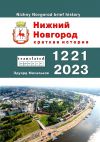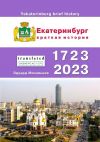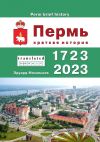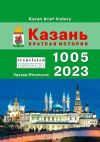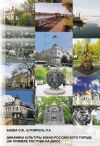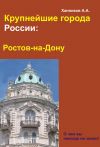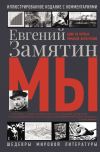Текст книги "Ростов-на-Дону. Краткая история"

Автор книги: Эдуард Михальков
Жанр: Документальная литература, Публицистика
сообщить о неприемлемом содержимом
Текущая страница: 1 (всего у книги 1 страниц)
Ростов-на-Дону. Краткая история
Эдуард Михальков
© Эдуард Михальков, 2023
ISBN 978-5-0060-5203-1
Создано в интеллектуальной издательской системе Ridero
RU
Ростов на Дону – один из старейших городов на территории России. Его история насчитывает множество значимых событий, которые привели к его развитию и становлению важным центром юга страны.
Основание города (1749 год)
Важной датой в истории Ростова на Дону является 1749 год, когда была создана Азовская крепость на слиянии рек Дона и Нижнего Дона. Это событие считается началом формирования города.
Во второй половине 18 века Ростовскую крепость переименовали в Ростов-на-Дону, и она стала играть важную роль в защите южных границ Российской империи.
В 1806 году Ростов стал уездным городом Воронежской губернии.
В 1809 году была основана первая регулярная улица в городе – улица Большая Садовая (ныне Большая Садовая).
В 1811 году в Ростове начал функционировать первый доселец Купеческая палата.
В 1846 году Ростов стал городом Воронежской губернии.
В 1861 году было открыто железнодорожное сообщение с Центральной Россией, что стало важным фактором в развитии экономики города.
В конце 19 века и начале 20 века Ростов на Дону стал промышленным центром. Здесь развернулись крупные предприятия по обработке зерна, производству масла, муки, цукра, а также металлургические заводы.
В 1903 году была открыта первая паровая мельница.
В 1907 году было заложено здание современного железнодорожного вокзала, что способствовало развитию транспортной инфраструктуры города.
Период Советской власти (20-е годы):
В 1920-е годы Ростов стал административным центром Ростовской области.
В 1930-е годы были проведены масштабные индустриализационные процессы, что привело к расширению промышленного комплекса города.
В 1936 году открылся Ростовский металлургический завод, который стал одним из крупнейших предприятий региона.
В период Великой Отечественной войны Ростов стал тыловым центром, а затем был оккупирован немецкими войсками.
В 1943 году Советские войска освободили Ростов от немецкой оккупации.
После войны город активно восстанавливался и развивался. В 1950-1960-е годы были построены многоэтажные жилые здания и социальные объекты.
В 1957 году открыт Ростовский государственный университет.
В 1961 году был заложен первый камень в основание Ростовского стадиона «Олимп-2».
В 1963 году открыт Ростовский художественный музей.
В 1968 году запущена в эксплуатацию первая очередь Ростовского метрополитена.
В 1980 году была построена Центральный мост через реку Дон, улучшив транспортные связи в городе.
В 2000-е годы Ростов на Дону стал одним из крупнейших экономических и культурных центров России.
Количественные данные о населении:
В период основания города в 1749 году численность населения была невелика и составляла несколько тысяч человек.
К началу 19 века население города превысило 10 тысяч жителей.
К 1861 году население Ростова составляло около 30 тысяч жителей.
К 1917 году численность населения увеличилась до 130 тысяч жителей.
В период Советской власти население продолжало расти, и в 2020 году превысило 1,1 миллиона жителей.
Ростов на Дону – это не только важный промышленный и транспортный центр, но и родина многих известных людей.
EN
Rostov on Don is one of the oldest cities in Russia. Its history counts many significant events that led to its development and becoming an important center of the south of the country.
Founding of the city (1749)
An important date in the history of Rostov on the Don is 1749, when the Azov fortress was established at the confluence of the Don and Lower Don rivers. This event is considered the beginning of the formation of the city.
In the second half of the 18th century, the Rostov fortress was renamed Rostov-on-Don, and it began to play an important role in the defense of the southern borders of the Russian Empire.
In 1806 Rostov became a district town of Voronezh province.
In 1809 the first regular street in the city – Bolshaya Sadovaya Street (now Bolshaya Sadovaya Street) was founded.
In 1811 the first dosselets Merchant Chamber started functioning in Rostov.
In 1846 Rostov became a city of Voronezh province.
In 1861 a railroad connection with Central Russia was opened, which became an important factor in the development of the city's economy.
At the end of the 19th century and the beginning of the 20th century Rostov on Don became an industrial center. Large enterprises for grain processing, production of oil, flour, tsukr, as well as metallurgical plants were established here.
In 1903 the first steam mill was opened.
In 1907 the building of the modern railway station was laid, which contributed to the development of transportation infrastructure of the city.
The period of Soviet power (the 1920s):
In the 1920s Rostov became the administrative center of Rostov Oblast.
In the 1930s, large-scale industrialization processes were carried out, which led to the expansion of the city's industrial complex.
In 1936 Rostov Metallurgical Plant was opened, which became one of the largest enterprises in the region.
During the Great Patriotic War Rostov became a rear center, and then was occupied by German troops.
In 1943 Soviet troops liberated Rostov from German occupation.
After the war, the city was actively restored and developed. In 1950-1960s multi-storey residential buildings and social facilities were built.
In 1957 Rostov State University was opened.
In 1961 the first stone was laid in the foundation of Rostov stadium "Olymp-2".
In 1963 the Rostov Art Museum was opened.
In 1968 the first stage of Rostov Metro was put into operation.
In 1980, the Central Bridge over the Don River was built, improving transportation links in the city.
In the 2000s Rostov on Don became one of the largest economic and cultural centers of Russia.
Quantitative data on the population:
At the time of the city's foundation in 1749, the population was small and amounted to a few thousand people.
By the beginning of the 19th century the population of the city exceeded 10 thousand inhabitants.
By 1861 the population of Rostov was about 30 thousand inhabitants.
By 1917 the population had increased to 130 thousand inhabitants.
During the Soviet period, the population continued to grow, and in 2020 exceeded 1.1 million inhabitants.
Rostov on Don is not only an important industrial and transport center, but also the birthplace of many famous people.
ESP
Rostov del Don es una de las ciudades más antiguas de Rusia. Su historia incluye muchos acontecimientos significativos que condujeron a su desarrollo y a que se convirtiera en un importante centro del sur del país.
Fundación de la ciudad (1749)
Una fecha importante en la historia de Rostov del Don es 1749, cuando se estableció la fortaleza de Azov en la confluencia de los ríos Don y Bajo Don. Este acontecimiento se considera el inicio de la formación de la ciudad.
En la segunda mitad del siglo XVIII, la fortaleza de Rostov pasó a llamarse Rostov del Don, y empezó a desempeñar un papel importante en la defensa de las fronteras meridionales del Imperio ruso.
En 1806, Rostov se convirtió en ciudad de distrito de la provincia de Voronezh.
En 1809 se fundó la primera calle regular de la ciudad: la calle Bolshaya Sadovaya (actual calle Bolshaya Sadovaya).
En 1811 comenzó a funcionar en Rostov la primera Cámara de Comerciantes dosselets.
En 1846 Rostov se convirtió en una ciudad de la provincia de Voronezh.
En 1861 se abrió la comunicación ferroviaria con Rusia Central, que se convirtió en un importante factor de desarrollo de la economía de la ciudad.
A finales del siglo XIX y principios del XX, Rostov del Don se convirtió en un centro industrial. Aquí se establecieron grandes empresas de procesamiento de grano, producción de aceite, harina y tsukr, así como plantas metalúrgicas.
En 1903 se inauguró el primer molino de vapor.
En 1907 se construyó la moderna estación de ferrocarril, que contribuyó al desarrollo de las infraestructuras de transporte de la ciudad.
El periodo del poder soviético (la década de 1920):
En la década de 1920 Rostov se convirtió en el centro administrativo de la provincia de Rostov.
En la década de 1930 se llevaron a cabo procesos de industrialización a gran escala, que condujeron a la expansión del complejo industrial de la ciudad.
En 1936 se inauguró la Planta Metalúrgica de Rostov, que se convirtió en una de las mayores empresas de la región.
Durante la Gran Guerra Patria, Rostov se convirtió en un centro de retaguardia y fue ocupada por las tropas alemanas.
En 1943, las tropas soviéticas liberaron Rostov de la ocupación alemana.
Tras la guerra, la ciudad fue activamente restaurada y desarrollada. En los años 1950-1960 se construyeron edificios residenciales de varias plantas e instalaciones sociales.
En 1957 se inauguró la Universidad Estatal de Rostov.
En 1961 se colocó la primera piedra del estadio de Rostov "Olymp-2".
En 1963 se inauguró el Museo de Arte de Rostov.
En 1968 se puso en funcionamiento la primera fase del metro de Rostov.
En 1980 se construyó el Puente Central sobre el río Don, que mejoró las comunicaciones de la ciudad.
En la década de 2000, Rostov del Don se convirtió en uno de los mayores centros económicos y culturales de Rusia
...
конец ознакомительного фрагмента
Внимание! Это не конец книги.
Если начало книги вам понравилось, то полную версию можно приобрести у нашего партнёра - распространителя легального контента. Поддержите автора!



